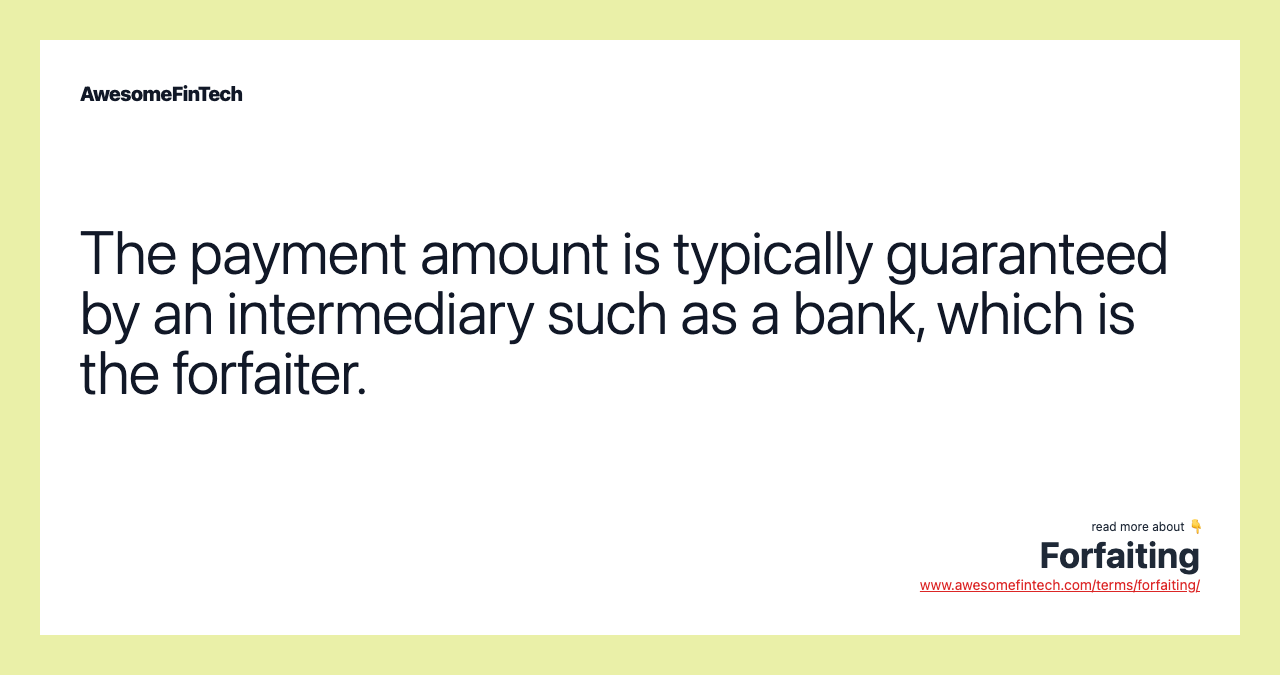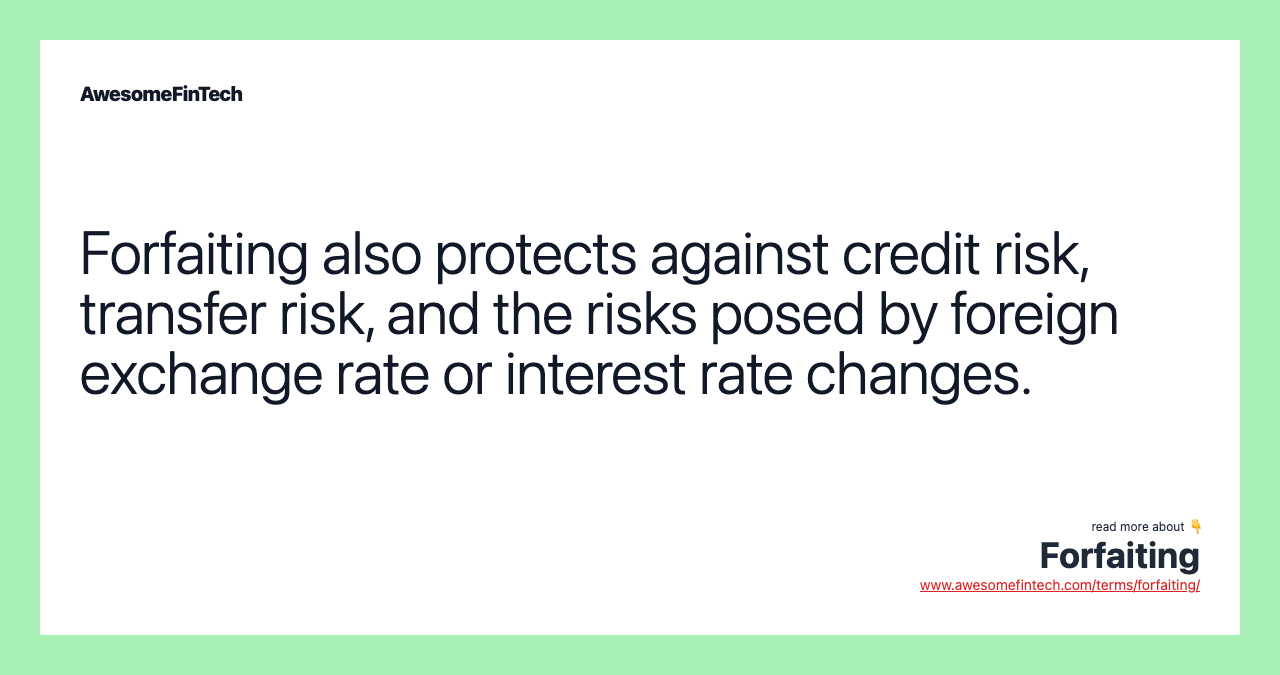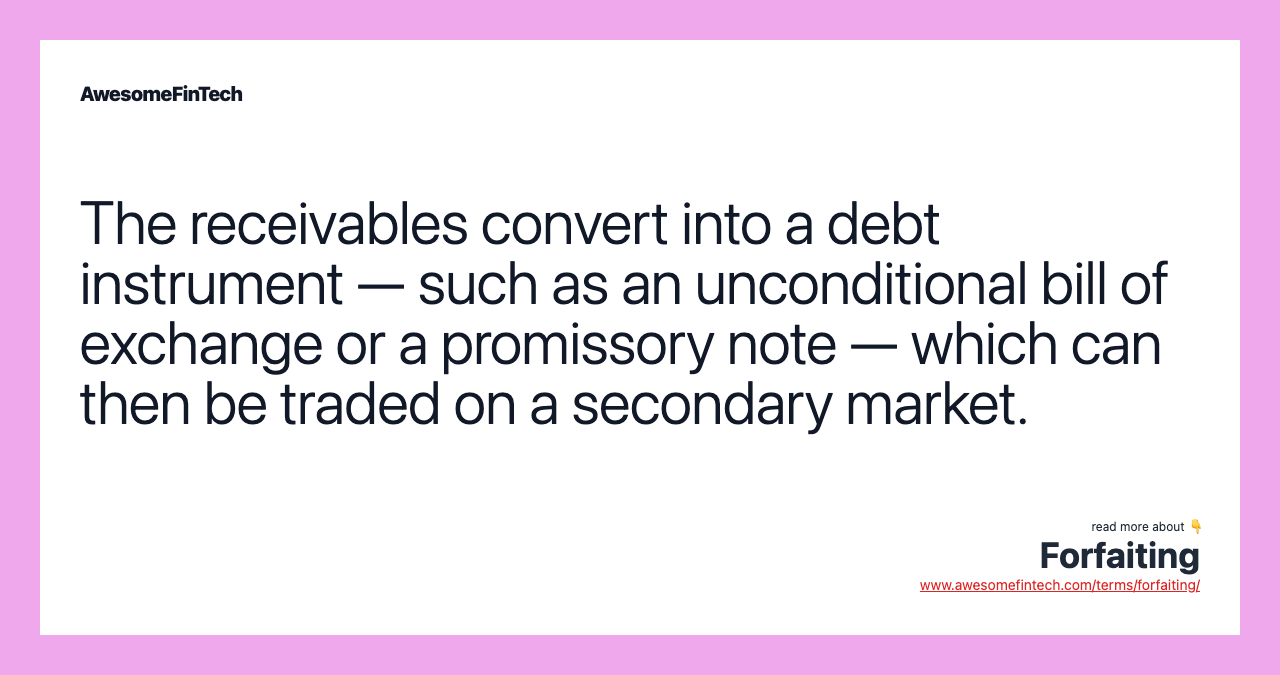Forfaiting
Forfaiting is a means of financing that enables exporters to receive immediate cash by selling their medium and long-term receivables — the amount an importer owes the exporter — at a discount through an intermediary. Forfaiting is a means of financing that enables exporters to receive immediate cash by selling their medium and long-term receivables — the amount an importer owes the exporter — at a discount through an intermediary. Forfaiting also protects against credit risk, transfer risk, and the risks posed by foreign exchange rate or interest rate changes. The receivables convert into a debt instrument — such as an unconditional bill of exchange or a promissory note — which can then be traded on a secondary market. While these debt instruments can have a range of maturities, most maturity dates are between one and three years from the time of sale. The practice also protects against credit risk, transfer risk, and the risks posed by foreign exchange rate or interest rate changes.

What Is Forfaiting?
Forfaiting is a means of financing that enables exporters to receive immediate cash by selling their medium and long-term receivables — the amount an importer owes the exporter — at a discount through an intermediary. The exporter eliminates risk by making the sale without recourse. It has no liability regarding the importer's possible default on the receivables.
The forfaiter is the individual or entity that purchases the receivables. The importer then pays the amount of the receivables to the forfaiter. A forfaiter is typically a bank or a financial firm that specializes in export financing.





How Forfaiting Works
A forfaiter's purchase of the receivables expedites payment and cash flow for the exporter. The importer's bank typically guarantees the amount.
The purchase also eliminates the credit risk involved in a credit sale to an importer. Forfaiting facilitates the transaction for an importer that cannot afford to pay in full for goods upon delivery.
The importer's receivables convert into a debt instrument that it can freely trade on a secondary market. The receivables are typically in the form of unconditional bills of exchange or promissory notes that are legally enforceable, thus providing security for the forfaiter or a subsequent purchaser of the debt.
These debt instruments have a range of maturities from as short as one month to as long as 10 years. Most maturities fall between one and three years from the time of sale.
Forfaiting is most commonly used in cases of large, international sales of commodities or capital goods where the price exceeds $100,000.
Advantages and Disadvantages of Forfaiting
Advantages
Forfaiting eliminates the risk that the exporter will receive payment. The practice also protects against credit risk, transfer risk, and the risks posed by foreign exchange rate or interest rate changes. Forfaiting simplifies the transaction by transforming a credit-based sale into a cash transaction. This credit-to-cash process gives immediate cash flow for the seller and eliminates collection costs. Additionally, the exporter can remove the accounts receivable, a liability, from its balance sheet.
Forfaiting is flexible. A forfaiter can tailor its offering to suit an exporter's needs and adapt it to a variety of international transactions. Exporters can use forfaiting in place of credit or insurance coverage for a sale. Forfaiting is helpful in situations where a country or a specific bank within the country does not have access to an export credit agency (ECA). The practice allows an exporter to transact business with buyers in countries with high levels of political risk.
Disadvantages
Forfaiting mitigates risks for exporters, but it is generally more expensive than commercial lender financing leading to higher export costs. These higher costs are generally pushed onto the importer as part of the standard pricing. Additionally, only transactions over $100,000 with longer terms are eligible for forfaiting, but forfaiting is not available for deferred payments.
Some discrimination exists where developing countries are concerned compared to developed countries. For example, only selected currencies are taken for forfaiting because they have international liquidity. Lastly, there is no international credit agency that can provide guarantees for forfaiting companies. This lack of guarantee affects long-term forfaiting.
Real World Example
The Black Sea Trade & Development Bank (BSTDB) lists forfaiting in its list of special products along with underwriting, hedging instruments, financial leasing, and discounting. BSTDB was established as a source of financing for development projects by 11 founding countries — Albania, Armenia, Azerbaijan, Bulgaria, Georgia, Greece, Moldova, Romania, Russia, Turkey, and Ukraine.
The bank explains that "the importer’s obligations are evidenced by accepted bills of exchange or promissory notes which a bank avals, or guarantees." The minimum operation size that BSTDB will finance through forfaiting is euro 5 million with a repayment period of one to five years. The bank may also apply option, commitment, termination, or discount rate fees.
Related terms:
Acceptance Market
An acceptance market is based on short-term credit instruments typically used by exporters who prefer to get paid faster for their exported goods. read more
At a Discount
"At a discount" is a phrase used to describe the practice of selling stocks, or other securities, below their current market value read more
Balance Sheet : Formula & Examples
A balance sheet is a financial statement that reports a company's assets, liabilities and shareholder equity at a specific point in time. read more
Banker's Acceptance (BA)
A banker's acceptance (BA) is like a post-dated check, but a bank rather than an account holder guarantees payment. BAs are sold at a discount in money markets. read more
Bill of Exchange
A bill of exchange is a written order binding one party to pay a fixed sum of money to another party on demand or at a predetermined date. read more
Bond Market
The bond market is the collective name given to all trades and issues of debt securities. Learn more about corporate, government, and municipal bonds. read more
Cash Flow
Cash flow is the net amount of cash and cash equivalents being transferred into and out of a business. read more
Commodity
A commodity is a basic good used in commerce that is interchangeable with other goods of the same type. read more
Credit Risk
Credit risk is the possibility of loss due to a borrower's defaulting on a loan or not meeting contractual obligations. read more